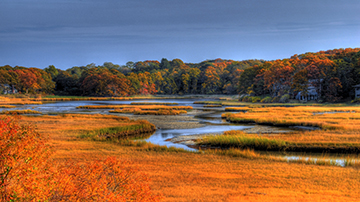In FY17, grants awarded to the ACJV contributed to the ACJV’s new focus on conservation of coastal marshes and three flagship species: American Black Duck, Black Rail, and Saltmarsh Sparrow. In FY17, 10 Standard North American Wetlands Conservation Act (NAWCA) grants, 11 NAWCA Small grants, 11 National Coastal Wetland Conservation grants, and 2 Great Lakes Restoration Initiative grants were awarded, conserving over 36,000 acres in 11 states. These 34 grants of nearly $20 million dollars were awarded to protect, restore, and enhance coastal marshes and habitat for the three flagship species and other high priority species in five Bird Conservation Regions.
Additionally, recent grant awards in the first cycle of FY18 have yielded further conservation acres for the new focus. Although the full cycle of grants for FY18 is just beginning, significant contributions to the conservation of flagship species and coastal marshes in the ACJV were funded by the Migratory Bird Conservation Commission, with five proposals leveraging over $12 million dollars and conserving nearly 12,000 acres approved. While all projects are outstanding, two projects were exceptional: Carolina Wetlands Initiative V and the Southeast New Jersey Coastal Initiative III.
The Carolina Wetlands Initiative V, with projects in both North and South Carolina, conserved nearly 3,000 acres of high priority wetlands in fee title acquisition and wetlands enhancements, with many of the acres having public access, including the Santee Coastal Reserve in South Carolina, a known location for breeding Black Rail. These thousands of acres of coastal marsh provide essential habitat for wintering American Black Duck and Saltmarsh Sparrow.
In New Jersey, approximately 1,800 acres of highly important salt marsh will be permanently protected, conserving habitat for several high priority species in one of the most important regions in the Mid-Atlantic for saltmarsh species. New Jersey hosts a third of the breeding population of the endemic Saltmarsh Sparrow and more than half of the wintering American Black Duck and Atlantic Brant population in the Atlantic Flyway. Additionally, significant populations of Seaside Sparrow, Clapper Rail, and Willet occur here, and conservation of these marshes is essential to the continued existence of many of these species.

